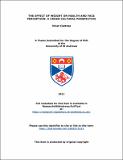Files in this item
The effect of weight on health and face perception : a cross-cultural perspective
Item metadata
| dc.contributor.advisor | Perett, David I. | |
| dc.contributor.author | Coetzee, Vinet | |
| dc.coverage.spatial | 149 | en_US |
| dc.date.accessioned | 2012-09-22T18:51:26Z | |
| dc.date.available | 2012-09-22T18:51:26Z | |
| dc.date.issued | 2011 | |
| dc.identifier.uri | https://hdl.handle.net/10023/3131 | |
| dc.description.abstract | My research identifies facial adiposity, a measure of weight in the face, as a novel facial cue to attractiveness and health. Previously identified facial cues, such as symmetry, averageness, sexual dimorphism and skin condition, are not consistently related to indices of actual health. In chapter 2 I demonstrate that facial adiposity is reliably associated with judgements of facial attractiveness and health in Caucasians and also with frequency and duration of respiratory infections, antibiotics use and blood pressure, indicating that facial adiposity is a valid cue to health. Additionally, in chapter 3 I identify three quantifiable facial shape cues that are reliably related to Body Mass Index (BMI) and are used by observers to judge weight in Caucasian and African faces. In chapter 4 I show that Western Caucasian women, but not men, prefer a significantly lower facial adiposity when judging attractiveness than when judging health in other women’s faces. This difference may reflect the influence of the media, since it was only significant in women’s judgements and previous work showed that women internalize media messages about body ideals more than men do. In contrast, African participants in chapter 6 did not show any difference between the optimal facial adiposity for health and attractiveness, which is consistent with the prediction that people living in an environment with a high disease burden will base their concept of attractiveness more closely on cues to health. Importantly, these different patterns of results for Western Caucasian and African participants are unlikely to be due to cultural differences in media ideals of beauty, since the new African body ideal portrayed by the South African media is closely aligned with the Western ideal (chapter 5). Thus, my research suggests that perceptions of facial adiposity may well be influenced by an interaction between environmental factors and media ideals. | en_US |
| dc.language.iso | en | en_US |
| dc.publisher | University of St Andrews | |
| dc.subject.lcc | BF859.C74 | |
| dc.subject.lcsh | Face perception | en_US |
| dc.subject.lcsh | Face--Health aspects | en_US |
| dc.subject.lcsh | Interpersonal attraction | en_US |
| dc.subject.lcsh | Body weight--Psychological aspects | en_US |
| dc.subject.lcsh | Body weight--Health aspects | en_US |
| dc.title | The effect of weight on health and face perception : a cross-cultural perspective | en_US |
| dc.type | Thesis | en_US |
| dc.type.qualificationlevel | Doctoral | en_US |
| dc.type.qualificationname | PhD Doctor of Philosophy | en_US |
| dc.publisher.institution | The University of St Andrews | en_US |
This item appears in the following Collection(s)
Items in the St Andrews Research Repository are protected by copyright, with all rights reserved, unless otherwise indicated.

